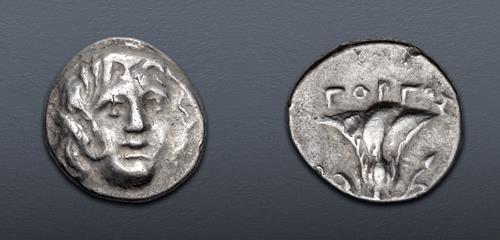
|
KINGS of MACEDON. temp. Perseus. 179-168 BC. AR Drachm (14mm, 2.73 g, 3h). Third Macedonian War issue. Uncertain mint in Thessaly; Gorgos, “magistrate”. Struck circa 171/0 BC. VF.
Electronic Auction 546
Lot: 79. Estimated: $ 100
Greek, Silver
Sold For $ 250. This amount does not include the buyer’s fee.
Go to Live
|
|
KINGS of MACEDON. temp. Perseus. 179-168 BC. AR Drachm (14mm, 2.73 g, 3h). Third Macedonian War issue. Uncertain mint in Thessaly; Gorgos, “magistrate”. Struck circa 171/0 BC. Head of Helios facing slightly right / Rose, with bud to right; ΓOPΓOΣ above, grape bunch to left. Ashton, Pseudo 22a (A12/P17 – this coin, illustrated). Struck from worn dies. VF.
Ex Thessaly 1985/5 hoard (CH VIII, 422).
Such Thessalian imitations of Rhodian drachms featuring a grape bunch on the reverse form a distinctive series from the Thessalian “Hermias” coinage. They are also much rarer – at the time of his publication Ashton knew of a total of only 95 coins from the grape bunch series bearing six different names (while approximately 750 of the Hermias drachms were found in the 1968 Thessaly Hoard alone). It has been convincingly argued that the Hermias drachms were struck to pay Cretan mercenaries serving in Perseus’ army, who would have desired to be paid in trusted Rhodian-style currency, and were issued under the authority of Hermias, son of Zoilos, a supporter of Perseus from Oropos. The names on the grape bunch series, however, copy those of genuine Rhodian drachms from the early 2nd century BC, ostensibly “to encourage acceptance of the coinage by Cretan mercenaries” (Ashton p. 32). While we know from hoard evidence that coins of the grape bunch series were circulating in the region of Thessaly, and that the reason for their striking was doubtless prompted by the presence there of large numbers of Cretan mercenaries in the region during Perseus’ campaigns against the Roman army, the question of the minting authority is uncertain. Ashton (p. 32) notes “...it is not possible to determine whether these coins were issued by an official Macedonian mint (either traveling with Perseus’ army or static), or by Larissa or some neighboring authority.”
Closing Date and Time: 13 September 2023 at 10:26:00 ET.
All winning bids are subject to an 20% buyer’s fee.
|
